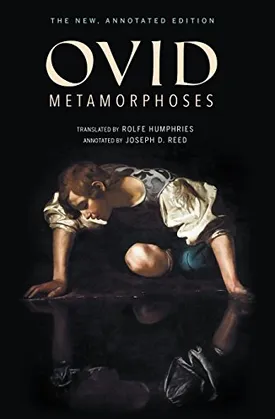Metamorphoses by Ovid
Metamorphoses by Ovid is an epic poem written by the Roman poet Ovid, which strives to chronicle the history of creation, from the transformation of the gods to the adventures of mortals. Written in dactylic hexameter, the epic consists of fifteen books and has variously been described and characterized as an artistic masterpiece, a cultural phenomenon, and an essential canon of the Western literary tradition.
First published in 8 A.D., Metamorphoses stands out from other ancient works in its remarkably imaginative cosmology. Taking its cue from earlier hints at a transformative universe, in which everything—gods, humans, nature—is fluid, fluxing and changing, it paints a vivid picture of a world in which metamorphoses are not just possible, but are actually everywhere. From the transformations of Daphne into a laurel tree and of Cadmus into a dragon to the mythical stories about Narcissus and Midas, the Metamorphoses captures in poetic form the formative power of natural and mortal forces.
The poem begins with the creation narrative of the gods, depicting their adventures and transformations—from Uranus and Gaea giving rise to the Titans, to the birth of Zeus and the overthrow of the Titans, and so forth. This creation narrative provides the foundation on which the rest of the stories will depend, and stands as a distinct and fascinating chapter of the poem.
The main narrative, however, is a tale of changes in men and women, in creatures and nature, as well as in gods. From the first of the heroes—Daedalus and Icarus, Phaëthon, and others—to the myths of actaeon, Caenus, and Pygmalion, followed by the story of the flood, Metamorphoses is replete with tales of transformation, each of them shocking and fascinating all at once. One of the most remarkable moments in the poem is the transformation of Daphne into a laurel tree, the moment in which death and life, mortality and eternity, all come together. Ovid’s incorporation of this story in his epic poem, so full of its own transformations, is a breathtakingly poetic way to explore the power of both change and creativity at the same time.
Among the most famous characters in Ovid's tale is the mythic beauty of Narcissus, whose obsessive self-love turns to blindness and finally death. This story stands as a powerful reminder of the consequences of vanity and the need to find balance among passion and moderation. Ovid also includes stories of Midas and his golden touch and of Baucis and Philemon, who sacrifice their home and belongings in order to save the gods—all fables of lessons learned and unforgettable wisdom.
In the last of the books, Ovid takes a moral turn and looks at the dangers of lust, embarking on a moral journey to show how the gods must intervene in order to save humans from themselves. Through its long winding stories, Metamorphoses is ultimately a hymn to life and to the power of love and human expression. In this way, Ovid’s epic poem stands out as one of the most essential texts of the Western literary canon.

